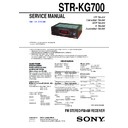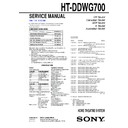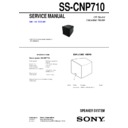Sony HT-DDWG700 / STR-KG700 Service Manual ▷ View online
SERVICE MANUAL
Published by Sony EMCS (Malaysia) PG Tec
Sony Corporation
Audio & Video Business Group
STR-KG700
FM STEREO/FM-AM RECEIVER
9-890-501-05
2010H08-1
©
2010.08
US Model
Canadian Model
AEP Model
E Model
Australian Model
Ver. 1.4 2010.08
• STR-KG700 is the tuner and the amplifi er
section in HT-DDWG700
section in HT-DDWG700
This receiver incorporates Dolby* Digital and Pro Logic Surround and the DTS** Digital Surround System.
* Manufactured under license from Dolby Laboratories.
* Manufactured under license from Dolby Laboratories.
Dolby, Pro Logic, and the double-D symbol are trademarks of Dolby Laboratories.
** Manufactured under license under U.S. Patent
#’s: 5,451,942; 5,956,674; 5,974,380; 5,978,762; 6,487,535 & other U.S. and worldwide patents issued & pending.
DTS and DTS Digital Surround are registered trademarks and the DTS logos and Symbol are trademarks of DTS, Inc.
© 1996-2007 DTS, Inc. All Rights Reserved.
SPECIFICATIONS
AUDIO POWER
SPECIFICATIONS
SPECIFICATIONS
POWER OUTPUT AND TOTAL
HARMONIC DISTORTION:
(Models of area code US only)
With 6 ohm loads, both channels driven, from
120 - 20,000 Hz; rated 85 watts per channel
minimum RMS power, with no more than 1%
total harmonic distortion from 250 milliwatts
to rated output.
With 6 ohm loads, both channels driven, from
120 - 20,000 Hz; rated 85 watts per channel
minimum RMS power, with no more than 1%
total harmonic distortion from 250 milliwatts
to rated output.
Amplifi er section
Models of area code AEP, AUS, E51, AR2
Power Output
Stereo mode (rated) (6ohms 1kHz, THD 1%)
Models of area code AEP, AUS, E51, AR2
Power Output
Stereo mode (rated) (6ohms 1kHz, THD 1%)
85 W + 85 W
1)
80 W + 80 W
2)
Surround mode
3)
(reference)
(6 ohms 1 kHz, THD 10%)
RMS output
FRONT:
133 W per channel
1)
125 W per channel
2)
CENTER:
133 W
1)
125
W
2)
SURROUND:
133 W per channel
1)
125 W per channel
2)
Surround mode
3)
(reference)
(6 ohms 100 Hz, THD 10%)
SUB WOOFER:
SUB WOOFER:
135 W
1)
125
W
2)
1)
Measured under the following conditions:
Area Code
Power requirements
US, Canadian
120 V AC, 60 Hz
E51
240 V AC, 50 Hz
AEP, AUS, AR
230 V AC, 50 Hz
2)
Measured under the following conditions:
Area Code
Power requirements
AR
220 V AC, 50 Hz
3)
Reference power output for front, center,
surround speakers and subwoofer. Depending
on the sound fi eld settings and the source, there
may be no sound output.
surround speakers and subwoofer. Depending
on the sound fi eld settings and the source, there
may be no sound output.
Inputs
Analog
Analog
Sensitivity: 800mV/
50 kohms
Digital (Coaxial) Impedance: 75 ohms
Tone
Gain levels
Tone
Gain levels
±6 dB, 1 dB step
Reproduction frequency range:
28-20,000 Hz
FM tuner section
Tuning range
Tuning range
87.5 - 108.0 MHz
Antenna
FM wire antenna
Antenna terminals
75 ohms, unbalanced
Intermediate frequency
10.7 MHz
AM tuner section
Tuning range
Area code
Tuning scale
10 kHz step 9 kHz step
US, Canadian
530 –
531 –
1,710 kHz
4)
1,710 kHz
4)
AEP, AUS
–
531 –
1,602 kHz
E51
530 –
531 –
1,610 kHz
1,602 kHz
AR
530 –
–
1,610 kHz
Antenna Loop
antenna
Intermediate frequency
450 kHz
- Continued on next page -
STR-KG700
2
SAFETY CHECK-OUT
After correcting the original service problem, perform the
following safety check before releasing the set to the customer:
Check the antenna terminals, metal trim, “metallized” knobs,
screws, and all other exposed metal parts for AC leakage.
Check leakage as described below.
After correcting the original service problem, perform the
following safety check before releasing the set to the customer:
Check the antenna terminals, metal trim, “metallized” knobs,
screws, and all other exposed metal parts for AC leakage.
Check leakage as described below.
LEAKAGE TEST
The AC leakage from any exposed metal part to earth ground and
from all exposed metal parts to any exposed metal part having a
return to chassis, must not exceed 0.5 mA (500 microamperes.).
Leakage current can be measured by any one of three methods.
return to chassis, must not exceed 0.5 mA (500 microamperes.).
Leakage current can be measured by any one of three methods.
1. A commercial leakage tester, such as the Simpson 229 or
RCA WT-540A. Follow the manufacturers’ instructions to
use these instruments.
use these instruments.
2. A battery-operated AC miliammeter. The Data Precision
245 digital multimeter is suitable for this job.
3. Meausring the voltage drop across a resistor by means of a
VOM or battery-operated AC volmeter. The “limit
” indication is 0.75 V, so analog meters must have an
accurate low-voltage scale. The Simpson 250 and Sanwa
SH-63Trd are examples of a passive VOM that is suitable.
Nearly all battery operated digital multimeters that have a 2
V AC range are suitable. (See Fig. A)
” indication is 0.75 V, so analog meters must have an
accurate low-voltage scale. The Simpson 250 and Sanwa
SH-63Trd are examples of a passive VOM that is suitable.
Nearly all battery operated digital multimeters that have a 2
V AC range are suitable. (See Fig. A)
SAFETY-RELATED COMPONENT WARNING!!
COMPONENT IDENTIFIED BY MARK
OR DOTTED
LINE WITH MARK
ON THE SCHEMATIC DIAGRAMS
AND IN THE PARTS LIST ARE CRITICAL TO SAFE
OPERATION. REPLACE THESE COMPONENTS WITH
SONY PARTS WHOSE PART NUMBERS APPEAR
AS SHOWN IN THIS MANUAL OR IN SUPPLEMENTS
PUBLISHED BY SONY.
OPERATION. REPLACE THESE COMPONENTS WITH
SONY PARTS WHOSE PART NUMBERS APPEAR
AS SHOWN IN THIS MANUAL OR IN SUPPLEMENTS
PUBLISHED BY SONY.
ATTENTION AU COMPOSANT AYANT RAPPORT
À LA SÉCURITÉ!
LES COMPOSANTS IDENTIFIÉS PAR UNE MARQUE
SUR LES DIAGRAMMES SCHÉMATIQUES ET LA LISTE
DES PIÈCES SONT CRITIQUES POUR LA SÉCURITÉ
DE FONCTIONNEMENT. NE REMPLACER CES COM-
POSANTS QUE PAR DES PIÈCES SONY DONT LES
NUMÉROS SONT DONNÉS DANS CE MANUEL OU
DANS LES SUPPLÉMENTS PUBLIÉS PAR SONY.
DES PIÈCES SONT CRITIQUES POUR LA SÉCURITÉ
DE FONCTIONNEMENT. NE REMPLACER CES COM-
POSANTS QUE PAR DES PIÈCES SONY DONT LES
NUMÉROS SONT DONNÉS DANS CE MANUEL OU
DANS LES SUPPLÉMENTS PUBLIÉS PAR SONY.
4)
You can change the AM tuning scale to 9 kHz or 10 kHz. After tuning
in any AM station, turn off the receiver. While holding down MOVIE ,
press &/1. All preset stations will be erased when you change the tun-
ing scale. To reset the scale to 10 kHz (or 9 kHz), repeat the procedure.
in any AM station, turn off the receiver. While holding down MOVIE ,
press &/1. All preset stations will be erased when you change the tun-
ing scale. To reset the scale to 10 kHz (or 9 kHz), repeat the procedure.
General
Power requirements
Area code
Tuning scale
US, Canadian
120 V AC, 60 Hz
AEP
230 V AC, 50/60 Hz
AUS
230 V AC, 50 Hz
E51
120/220/240V AC, 50/60 Hz
AR
220 – 230 V AC, 50/60 Hz
Power output (DIGITAL MEDIA PORT)
DC OUT:
DC OUT:
5 V, 0.7 A MAX
Power consumption
Area code
Tuning scale
US
220W
Canadian
290VA
AEP, AUS
220W
E51, AR
220 W
Power consumption (during standby mode)
0.3 W
Dimensions (width/height/depth) (Approx.)
17 × 5
3
/
4
× 12
1
/
8
inches
430 × 145 × 306 mm
including projecting parts and controls
16 lb 6oz (7.4 kg) (US, Canadian)
Mass (Approx.)
7.7 kg
Design and specifi cations are subject to
change without notice.
change without notice.
• Abbreviation
AR : Argentina model
AUS : Australian model
E51 : Chilean and Peruvian model
AR : Argentina model
AUS : Australian model
E51 : Chilean and Peruvian model
Notes on chip component replacement
• Never reuse a disconnected chip component.
• Notice that the minus side of a tantalum capacitor may be
• Never reuse a disconnected chip component.
• Notice that the minus side of a tantalum capacitor may be
damaged by heat.
UNLEADED SOLDER
Boards requiring use of unleaded solder are printed with the lead-
free mark (LF) indicating the solder contains no lead.
(Caution: Some printed circuit boards may not come printed with
Boards requiring use of unleaded solder are printed with the lead-
free mark (LF) indicating the solder contains no lead.
(Caution: Some printed circuit boards may not come printed with
the lead free mark due to their particular size)
: LEAD FREE MARK
Unleaded solder has the following characteristics.
• Unleaded solder melts at a temperature about 40°C higher
• Unleaded solder melts at a temperature about 40°C higher
than ordinary solder.
Ordinary soldering irons can be used but the iron tip has to be
applied to the solder joint for a slightly longer time.
Soldering irons using a temperature regulator should be set to
about 350°C.
Caution: The printed pattern (copper foil) may peel away if
Caution: The printed pattern (copper foil) may peel away if
the heated tip is applied for too long, so be careful!
• Strong viscosity
Unleaded solder is more viscou-s (sticky, less prone to fl ow)
Unleaded solder is more viscou-s (sticky, less prone to fl ow)
than ordinary solder so use caution not to let solder bridges
occur such as on IC pins, etc.
occur such as on IC pins, etc.
• Usable with ordinary solder
It is best to use only unleaded solder but unleaded solder may
It is best to use only unleaded solder but unleaded solder may
also be added to ordinary solder.
Fig.A. Using an AC voltmeter to check AC leakage.
1.5 k
Ω
0.15
μ
F
AC
voltmeter
(0.75 V )
voltmeter
(0.75 V )
To Exposed Metal
Parts on Set
Earth Ground
Ver. 1.3
STR-KG700
3
1. GENERAL
.................................................................. 4
2.
TEST MODE
.............................................................. 12
3.
ELECTRICAL ADJUSTMENT
............................ 14
4. DIAGRAMS
............................................................... 15
4-1. Block Diagram ‒ MAIN Section ‒ ................................ 16
4-2. Block Diagram – DISPLAY/POWER Section – ............ 17
4-3. Block Diagram – HDMI Section – ................................. 18
4-4. Printed Wiring Board – DIGITAL Board (Side A) – ...... 19
4-5. Printed Wiring Board – DIGITAL Board (Side B) – ...... 20
4-6. Schematic Diagram – DIGITAL Board (1/3) –............... 21
4-7. Schematic Diagram – DIGITAL Board (2/3) –............... 22
4-8. Schematic Diagram – DIGITAL Board (3/3) –............... 23
4-9. Printed Wiring Boards – HDMI SW Board,
4-3. Block Diagram – HDMI Section – ................................. 18
4-4. Printed Wiring Board – DIGITAL Board (Side A) – ...... 19
4-5. Printed Wiring Board – DIGITAL Board (Side B) – ...... 20
4-6. Schematic Diagram – DIGITAL Board (1/3) –............... 21
4-7. Schematic Diagram – DIGITAL Board (2/3) –............... 22
4-8. Schematic Diagram – DIGITAL Board (3/3) –............... 23
4-9. Printed Wiring Boards – HDMI SW Board,
HDMI BRIDGE Board (AEP only) – ............................. 24
4-10. Schematic Diagram – HDMI SW Board,
HDMI BRIDGE Board (AEP only) – ............................. 25
4-11. Printed Wiring Board – MAIN Board – .......................... 26
4-12. Schematic Diagram – MAIN Board (1/3) – .................... 27
4-13. Schematic Diagram – MAIN Board (2/3) – .................... 28
4-14. Schematic Diagram – MAIN Board (3/3) – .................... 29
4-15. Printed Wiring Board – DISPLAY Board – .................... 30
4-16. Schematic Diagram – DISPLAY Board – ....................... 31
4-17. Printed Wiring Board – STANDBY Board,
4-12. Schematic Diagram – MAIN Board (1/3) – .................... 27
4-13. Schematic Diagram – MAIN Board (2/3) – .................... 28
4-14. Schematic Diagram – MAIN Board (3/3) – .................... 29
4-15. Printed Wiring Board – DISPLAY Board – .................... 30
4-16. Schematic Diagram – DISPLAY Board – ....................... 31
4-17. Printed Wiring Board – STANDBY Board,
DCDC Board – ................................................................ 32
4-18. Schematic Diagram – STANDBY Board,
DCDC Board – ................................................................ 33
4-19. Printed Wiring Boards – POWER Board, DCAC Board,
HEADPHONE Board – .................................................. 34
4-20. Schematic Diagram – POWER Board, DCAC Board,
HEADPHONE Board – .................................................. 35
4-21. Printed Wiring Boards – AC SELECT Board – .............. 36
4-22. Schematic Diagram – AC SELECT Board – .................. 36
4-22. Schematic Diagram – AC SELECT Board – .................. 36
5.
EXPLODED VIEWS
5-1. Case (Front) Section ....................................................... 47
5-2. Case (Rear) Section ........................................................ 48
5-2. Case (Rear) Section ........................................................ 48
6.
ELECTRICAL PARTS LIST
................................. 49
TABLE OF CONTENTS
Parts No.
About area codes
The area code of the receiver you purchased is
shown on the lower right portion of the rear panel
(see the illustration below).
shown on the lower right portion of the rear panel
(see the illustration below).
Any differences in operation, according to the area
code, are clearly indicated in the text, for example,
“Models of area code AA only”.
code, are clearly indicated in the text, for example,
“Models of area code AA only”.
FR ONT
CENTER
L
R
Area code
MODEL IDENTIFICATION
- Rear Panel -
- Rear Panel -
Model
Part No.
US model
3-279-682-0
Canadian model
3-279-682-1
AEP model
3-279-682-2
Australian model
3-279-682-6
Argentina model
3-279-682-7
Chilean and Peruvian model
3-279-682-8
Ver. 1.3
STR-KG700
4
Front panel
.
Receiver
VIDEO IN/
PORTABLE AUDIO IN/
PHONES
INPUT SELECTOR
A.F.D.
MOVIE
MUSIC
?/1
DIMMER
SLEEP
2CH
DISPLAY
MASTER VOLUME
INPUT MODE
qa
q;
qs
1
4
2
3
6
5
7
8
9
Name
Function
A ?/1
(on/standby)
Press to turn the receiver on or
off (Page 23, 30, 31, 44).
off (Page 23, 30, 31, 44).
B DIMMER
Press to adjust the brightness of
the display.
the display.
C SLEEP
Press to activate the Sleep
Timer function and the duration
which the receiver turns off
automatically (Page 54).
Timer function and the duration
which the receiver turns off
automatically (Page 54).
D Display
The current status of the
selected component or a list of
selectable items appears here
(Page 6).
selected component or a list of
selectable items appears here
(Page 6).
E DISPLAY
Press to select information
displayed on the display
displayed on the display
F INPUT MODE Press to select the input mode
when the same components are
connected to both digital and
analog jacks (Page 50).
connected to both digital and
analog jacks (Page 50).
G MASTER
VOLUME
Turn to adjust the volume level
of
(Page 28, 29,30, 31).
of
(Page 28, 29,30, 31).
all speakers at the same time.
Name
Function
H INPUT
SELECTOR
Turn to select the input source
to play back (Page 29).
to play back (Page 29).
I Remote
sensor
Receives signals from remote
commander.
commander.
J 2CH
Pres
(Page 41, 42, 44).
(Page 41, 42, 44).
s to select a sound field
A.F.D.
MOVIE
MUSIC
K VIDEO IN/
PORTABLE
AUDIO IN/
AUTO CAL
MIC jack
AUDIO IN/
AUTO CAL
MIC jack
– Connects to a portable audio
such as MP3
(Page 16).
(Page 16).
player, etc
– Connects to the supplied
optimizer microphone for
the Auto Calibration
function (Page 25).
the Auto Calibration
function (Page 25).
L PHONES jack Co
(Page 59).
nnects to headphones
(Page 54).
AUTO CAL MIC (AEP only)
SECTION 1
GENERAL
Note:
This section is extracted
from instruction manual.
This section is extracted
from instruction manual.
Ver. 1.3



